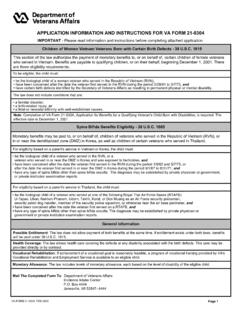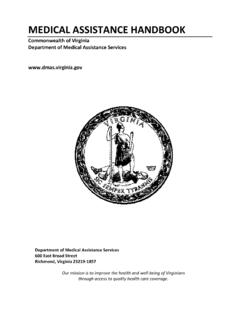Transcription of Equality Act 2010 Guidance - GOV.UK
1 Equality Act 2010 GuidanceGuidance on matters to be taken into account in determining questions relating to the definition of disabilityEquality Act 2010 Guidance on matters to be taken into account in determining questions relating to the definition of disability1 ContentsStatus and purpose of the Guidance 3 Part 1: Introduction 4 Using the Guidance 4 Other references to disability 5 Part 2: Guidance on matters to be taken into account in determining questions relating to the definition of disability 7 Section A: The Definition 7 Main elements of the definition of disability 7 Meaning of impairment 8 Persons with HIV infection, cancer and multiple sclerosis 10 Exclusions from the definition 11 People who have had a disability in the past 13 Section B: Substantial 14 Meaning of substantial adverse effect 14 The way in which an activity is carried out 15 Cumulative effects of an impairment 16 Effects of behaviour 17 Effects of environment 20 Effects of treatment 21 Progressive conditions 23 Equality Act 2010 Guidance on matters to be taken into account in determining questions relating to the definition of disability2 Section C.
2 Long-term 27 Meaning of long-term effects 27 Meaning of likely 28 Recurring or fluctuating effects 29 Likelihood of recurrence 32 Assessing whether a past disability was long-term 33 Section D: Normal day-to-day activities 34 Meaning of normal day-to-day activities 34 Specialised activities 36 Adverse effects on the ability to carry out normal day-to-day activities 37 Environmental effects 43 Indirect effects 45 Effect of treatment or correction measures 47 Section E: Disabled children 48 Section F: Disability as a particular protected characteristic or as a shared protected characteristic 51 Appendix 53An illustrative and non-exhaustive list of factors which, if they are experienced by a person, it would be reasonable to regard as having a substantial adverse effect on normal day-to-day activities.
3 53An illustrative and non-exhaustive list of factors which, if they are experienced by a person, it would not be reasonable to regard as having a substantial adverse effect on normal day-to-day activities. 56 Notes 58 Equality Act 2010 Guidance on matters to be taken into account in determining questions relating to the definition of disability3 Status and purpose of the guidanceThis Guidance is issued by the Secretary of State under section 6(5) of the Equality Act 2010 . In this document, any reference to the Act means the Equality Act Guidance concerns the definition of disability in the Act. Section 6(5) of the Act enables a Minister of the Crown to issue Guidance about matters to be taken into account in determining whether a person is a disabled person.
4 The Guidance gives illustrative Guidance does not impose any legal obligations in itself, nor is it an authoritative statement of the law. However, Schedule 1, Paragraph 12 to the Act requires that an adjudicating body1 which is determining for any purpose of the Act whether a person is a disabled person, must take into account any aspect of this Guidance which appears to it to be Guidance applies to England, Wales and Scotland. Similar, but separate, Guidance applies to Northern Act 2010 Guidance on matters to be taken into account in determining questions relating to the definition of disability4 Part 1: IntroductionThe Equality Act 20101. The Equality Act 2010 prohibits discrimination against people with the protected characteristics that are specified in section 4 of the Act.
5 Disability is one of the specified protected characteristics. Protection from discrimination for disabled people applies to disabled people in a range of circumstances, covering the provision of goods, facilities and services, the exercise of public functions, premises, work, education, and associations. Only those disabled people who are defined as disabled in accordance with section 6 of the Act, and the associated Schedules and regulations made under that section, will be entitled to the protection that the Act provides to disabled people. However, the Act also provides protection for non-disabled people who are subjected to direct discrimination or harassment because of their association with a disabled person or because they are wrongly perceived to be disabled.
6 Using the guidance2. This Guidance is primarily designed for adjudicating bodies which determine cases brought under the Act. The definition of disability for the purposes of the Act is a legal definition and it is only adjudicating bodies which can determine whether a person meets that definition. However, the Guidance is also likely to be of value to a range of people and organisations as an explanation of how the definition operates. 3. In the vast majority of cases there is unlikely to be any doubt whether or not a person has or has had a disability, but this Guidance should prove helpful in cases where the matter is not entirely Act 2010 Guidance on matters to be taken into account in determining questions relating to the definition of disability54.
7 The Act generally defines a disabled person as a person with a disability. A person has a disability for the purposes of the Act if he or she has a physical or mental impairment and the impairment has a substantial and long-term adverse effect on his or her ability to carry out normal day-to-day activities. Therefore, the general definition of disability has a number of elements. The Guidance covers each of these elements in turn. Each section contains an explanation of the relevant provisions of the Act which supplement the basic definition. Guidance and illustrative examples are provided where relevant. Those using this Guidance for the first time should read it all, as each part of the Guidance builds upon the part(s) preceding it.
8 It is important not to consider any individual element in isolation. 5. Throughout the Guidance , descriptions of statutory provisions in the legislation are immediately preceded by bold text and followed by a reference to the relevant provision of the Act or to regulations made under the Act. References to sections of the Act are marked S ; references to schedules are marked Sch ; and references to paragraphs in schedules are marked Para .Other references to disability 6. The definition of disability set out in the Act and described in this Guidance is the only definition relevant to determining whether someone is a disabled person for the purposes of the Act.
9 References to disability or to mental or physical impairments in the context of other legislation are not necessarily relevant but may assist adjudicating bodies when determining whether someone is a disabled person in accordance with the definition in this Act 2010 Guidance on matters to be taken into account in determining questions relating to the definition of disability67. There is a range of services, concessions, schemes and financial benefits for which disabled people may qualify. These include, for example: local authority services for disabled people; the Blue Badge parking scheme; tax concessions for people who are blind; and disability-related social security benefits .
10 However, each of these has its own individual eligibility criteria and qualification for any one of them does not automatically confer entitlement to protection under the Act, nor does entitlement to the protection of the Act confer eligibility for benefits , or concessions. Similarly, a child who has been identified as having special educational needs is not necessarily disabled for the purposes of the Act. However, having eligibility for such benefits may assist a person to demonstrate that they meet the definition in the In order to be protected by the Act, a person must have an impairment that meets the Act s definition of disability, or be able to establish that any less favourable treatment or harassment is because of another person s disability or because of a perceived Act 2010 Guidance on matters to be taken into account in determining questions relating to the definition of disability7 Part 2: Guidance on matters to be taken into account in determining questions relating to the definition of disability Section A.











